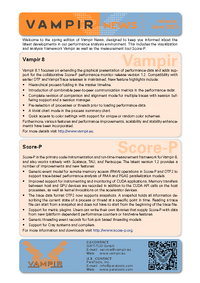Vampir meets ISC '13
 16
16Jun
2013
Welcome to the spring edition of Vampir News, designed to keep you informed about the latest developments in our performance analysis environment. This includes the visualization and analysis framework Vampir as well as the measurement tool Score-P.
Vampir
Vampir 8.1 focuses on extending the graphical presentation of performance data and adds support for the collaborative Score-P performance monitor release version 1.2. Compatibility with earlier OTF and VampirTrace releases is maintained. New feature highlights include:
- Hierarchical process folding in the master timeline.
- Introduction of combinable peer-to-peer communication metrics in the performance radar.
- Complete revision of comparison and alignment mode for multiple traces with session buffering support and a session manager.
- Pre-selection of processes or threads prior to loading performance data.
- A kiviat chart mode in the process summary chart.
- Quick access to color settings with support for unique or random color schemes.
Furthermore, various features and performance improvements, scalability and stability enhancements have been incorporated.
Score-P
Score-P is the primary code instrumentation and run-time measurement framework for Vampir 8, and also works natively with Scalasca, TAU, and Periscope. The latest version 1.2 provides a number of improvements and new features:
- Generic event model for remote memory access (RMA) operations in Score-P and OTF2 to support trace-based performance analysis of RMA and PGAS parallelization models.
- Improved support for instrumenting and monitoring of CUDA applications. Memory transfers between host and GPU devices are recorded in addition to the CUDA API calls on the host processes, as well as kernel invocations on the accelerator devices.
- The trace data format OTF2 now supports snapshots. A snapshot holds all information describing the current state of a process or thread at a specific point in time. Reading a trace file can start from a snapshot and does not have to start from the beginning of the trace file.
- Support for metric plugins. Users can write their own libraries that supply Score-P with data from new (platform dependent) performance counters or hardware features.
- Generic threading event records for fork-join based threading models.
- Support for Cray systems and compilers.
For more information and downloads visit www.score-p.org.